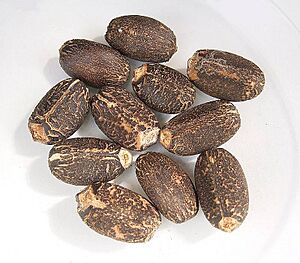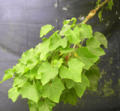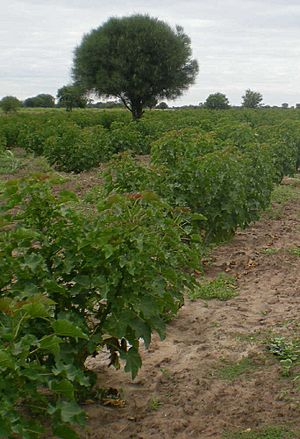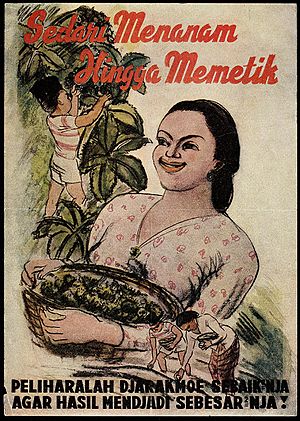Jatropha curcas facts for kids
Quick facts for kids Jatropha curcas |
|
|---|---|
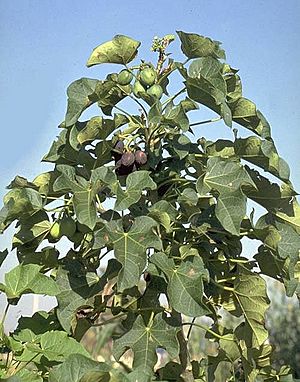 |
|
| Scientific classification | |
| Genus: |
Jatropha
|
| Species: |
curcas
|
Jatropha curcas is a type of flowering plant in the spurge family, called Euphorbiaceae. It originally comes from the American tropics, most likely Mexico and Central America. This plant has spread to tropical and subtropical areas all over the world. In many places, it has become an introduced or even invasive species.
The name "curcas" was first used by a Portuguese doctor named Garcia de Orta over 400 years ago. In English, it's often called physic nut, Barbados nut, poison nut, bubble bush, or purging nut. In parts of Africa and Asia, like India, it's sometimes called "castor oil plant." But it's not the same as the common castor oil plant, Ricinus communis, even though they are in the same plant family.
J. curcas is a semi-evergreen shrub or a small tree. It can grow to be 6 metres (20 feet) tall or even taller. This plant can handle very dry conditions, which means it can grow in deserts. It contains chemicals called phorbol esters, which are usually toxic. However, there are also edible (non-toxic) types found in Mexico. Local people call these "piñón manso," "xuta," "chuta," or "aishte." J. curcas also has other compounds like trypsin inhibitors, phytate, saponins, and a type of lectin called curcin.
The seeds of the plant contain 27–40% oil (on average, 34.4%). This oil can be turned into a good quality biodiesel fuel. This fuel can be used in a regular diesel engine. The oil itself has a strong laxative effect. The edible types, like those grown by native Mexicans in Veracruz, can be used for animal feed and even for human food.
Contents
What Jatropha Curcas Looks Like
This plant has several distinct parts that help identify it.
Leaves
The leaves of the Jatropha plant can look quite different from one plant to another. Generally, they are green to pale green. They grow alternately or nearly opposite each other on the stem. Each leaf usually has three to five lobes and grows in a spiral pattern.
Flowers
Both male and female Flowers grow on the same flower cluster, called an inflorescence. Usually, there are about 20 male flowers for every female flower, or sometimes 10 male flowers for each female flower. These flower clusters can grow in the leaf axil (the angle between a leaf and the stem). Sometimes, plants might even have flowers that are both male and female.
Fruits
The Fruits usually appear in winter. However, if the soil has enough moisture and temperatures are warm, the plant can produce several fruit crops throughout the year. Most fruits are produced from mid-summer to late fall. Some plants might have two or three harvests, while others produce fruits continuously during the growing season.
Seeds
The Seeds are ready when the fruit capsule changes color from green to yellow. These seeds contain about 20% saturated fatty acids and 80% unsaturated fatty acids. They can yield 25–40% oil by weight. The seeds also contain other chemicals like saccharose, raffinose, stachyose, glucose, fructose, galactose, and protein. The oil is mostly made of oleic and linoleic acids. The plant also contains curcasin, arachidic, myristic, palmitic, and stearic acids, as well as curcin.
Genome
The complete genetic map (called the Genome) of Jatropha curcas was mapped by the Kazusa DNA Research Institute in Chiba, Japan, in October 2010.
How Jatropha Curcas Reproduces
Jatropha curcas can easily be grown from both seeds and cuttings.
Some experts suggest growing the plant from seeds if you want a plantation that will last a long time. When jatropha plants grow from cuttings, they produce many branches but fewer seeds. They also don't have enough time to grow a deep main root, which makes them more easily affected by wind.
Jatropha seeds can be stored well. Under normal conditions, they will stay able to grow for eight months to a year. Growing plants from seeds (sexual reproduction) leads to a lot of differences in how the plants grow, how much they produce, and how much oil their seeds contain.
To get more consistent plants, people use cloning methods. This means growing new plants from parts of an existing plant. This has been done using stem cuttings, grafting, budding, and air layering techniques. Cuttings should ideally be taken from young plants. Treating them with 200 micrograms per liter of IBA (a rooting hormone) helps the stem cuttings grow roots better. However, cuttings can also grow roots easily just by being placed in the ground without hormones.
Growing Jatropha Curcas
Growing Jatropha curcas is not difficult. It grows well in tropical and subtropical areas. The plant can grow in wastelands and almost any type of ground. This includes gravelly, sandy, and even salty soils. It can do well in poor and stony soils. However, newer research suggests that the plant's ability to adapt to very poor soils might not be as great as once thought.
All seeds usually sprout within 9 days. Adding manure during the sprouting phase can actually be bad. But it is helpful if applied after the seeds have sprouted. The plant can also be grown from cuttings, which grow faster than plants grown from seeds.
Flowers only grow at the very end of a stem. So, a plant with many branches will produce the most fruits. The plants can self-pollinate. Another factor that affects how much fruit is produced is the number of female flowers compared to male flowers in a cluster. More female flowers mean more fruits.
Jatropha curcas can survive on just 250 mm (10 in) of rain a year. It only needs to be watered at the end of the dry season during its first two years. You don't need to plow or plant regularly, as this shrub can live for about forty years. Using pesticides is not needed because the plant itself has properties that fight pests and fungi. In rural Bengal, it is even used to treat dhobi itch, a common fungal skin infection.
While Jatropha curcas starts producing seeds in 9–12 months, the best yields are usually seen after 2–3 years. A hectare of land can produce about 3.5 tons of seeds. (Seed production can range from about 0.4 tons per hectare in the first year to over 5 tons per hectare after 3 years). If planted as hedges, the plant can produce about 0.8 to 1.0 kg of seeds for every meter of living fence.
Gallery
Processing Jatropha Seeds
Getting the oil out of jatropha seeds usually needs special equipment.
The oil content in the seeds varies from 28% to 30%. If you extract 80% of the oil, one hectare of jatropha plants can give you 400 to 600 liters of oil, assuming average soil conditions.
The oily seeds are processed into oil. This oil can be used directly (called "Straight Vegetable Oil") to power engines. Or, it can go through a process called transesterification to make biodiesel. Jatropha oil is not safe for people to eat. It causes strong vomiting and diarrhea.
Jatropha as Biofuel
When jatropha seeds are crushed, the oil can be processed into a high-quality biofuel or biodiesel. This fuel can be used in a regular diesel car or even further processed into jet fuel. The leftover material, called "press cake," can be used as fuel to power electricity plants. It can also be used as fertilizer because it contains nitrogen, phosphorus, and potassium. The cake can also be used in digesters and gasifiers to produce biogas.
There are different kinds of biofuel. They are often made using sedimentation, centrifugation, and filtration. The fats and oils are changed into esters, while the glycerin is separated. At the end of the process, the glycerin sinks, and the biofuel floats. The process of separating glycerin from biodiesel is called transesterification. Glycerin is another useful product from jatropha oil processing.
Transesterification is a simple chemical reaction. It neutralizes the free fatty acids in any fatty substance from jatropha. A chemical exchange happens between the alkoxy groups of an ester and an alcohol. Usually, methanol and ethanol are used for this. The reaction needs a catalyst, which is usually sodium hydroxide (NaOH) or potassium hydroxide (KOH). This forms fatty esters (like methyl or ethyl esters), which are commonly known as biodiesel. It takes about 10% of methyl alcohol by weight of the fatty substance to start the transesterification process.
The amount of seeds Jatropha plants produce can vary a lot. This is because there hasn't been much research, the plants have different genetics, they grow in many different environments, and they are perennial (live for many years). When grown carefully, seed yields can be from 1,500 to 2,000 kilograms per hectare. This means you can get 540 to 680 liters of oil per hectare (58 to 73 gallons per acre). In 2009, Time magazine suggested that one acre could potentially produce as much as 1,600 gallons of diesel fuel per year.
The plant might produce more than four times as much fuel per hectare as soybean. It could also produce more than ten times that of maize (corn). However, it also needs five times as much water per unit of energy produced as corn. One hectare of jatropha has been said to produce 1,892 liters of fuel. But since it hasn't been properly grown or improved by plant breeders yet, the yields can be different.
Jatropha can also be grown with other crops like coffee, sugar, fruits, and vegetables. This is called intercropping.
In 2007, Goldman Sachs said Jatropha curcas was one of the best plants for making biodiesel in the future. However, even though it's common and used for oil and restoring land, none of the Jatropha species have been properly domesticated. Because of this, how much they produce varies. Also, we don't fully know the long-term effects of growing it on a large scale on soil quality and the environment.
In 2008, researchers at Daimler Chrysler Research looked into using jatropha oil for cars. They found that even though jatropha oil as fuel "has not yet reached optimal quality," it "already fulfills the EU norm for biodiesel quality." Archer Daniels Midland Company, Bayer CropScience, and Daimler AG have a joint project to develop jatropha as a biofuel. Three Mercedes cars powered by Jatropha diesel have already driven about 30,000 kilometers. This project is supported by DaimlerChrysler and a German investment and development association (DEG).
Jatropha for Jet Fuel
Biofuels like jatropha oil might replace aviation fuels more easily than fuels for other types of transportation. There are fewer planes than cars or trucks. Also, there are far fewer jet fueling stations to change over compared to gas stations. To meet the yearly demand for aviation fuel, based on 2008 demand, an area of farmland twice the size of France would need to be planted with jatropha. This is based on average yields from mature plantations on good, irrigated land.
On December 30, 2008, Air New Zealand flew the first successful test flight from Auckland. A Boeing 747 used a 50:50 mix of jatropha oil and jet A-1 fuel in one of its four Rolls-Royce engines. In the same announcement, Air New Zealand said they planned to use this new fuel for 10% of their needs by 2013. At the time of this test, jatropha oil was much cheaper than crude oil. It cost about $43 a barrel, which was about one-third of the price of crude oil on June 4, 2008.
On January 7, 2009, Continental Airlines successfully completed a test flight from Houston, Texas. They used a 50/50 mixture of biofuel made from algae and jatropha oil, mixed with Jet A fuel. This was used in one of the two CFM56 engines of a Boeing 737-800 Next Generation jet. The two-hour test flight was another promising step for airlines to find cheaper and more environmentally friendly ways to power planes, instead of using fossil fuels.
On April 1, 2011, Interjet completed the first Mexican aviation biofuels test flight on an Airbus A320. The fuel was a 70:30 mix of traditional jet fuel and biojet fuel. It was made from Jatropha oil provided by three Mexican companies. Honeywell's UOP processed the oil into Bio-SPK (Synthetic Paraffinic Kerosene). Global Energías Renovables runs the largest Jatropha farm in the Americas.
On October 28, 2011, Air China completed the first successful demonstration flight by a Chinese airline using jatropha-based biofuel. The mixture was a 50:50 mix of regular jet fuel and jatropha oil from China National Petroleum Corp. The 747-400 powered one of its four engines with this fuel mix during a 1-hour flight around Beijing airport.
On August 27, 2018, SpiceJet completed the first successful test flight by an Indian airline using jatropha-based biofuel. The fuel was a 25:75 mix of regular jet fuel and jatropha oil.
Jatropha and Carbon Dioxide
A 2013 study by the European Geosciences Union suggested that the jatropha tree might help absorb carbon dioxide. Absorbing carbon dioxide is important in fighting climate change. This small tree is very resistant to dry conditions. So, it can be planted in hot, dry land that isn't good for growing food. However, the plant does need water to grow. This means coastal areas where desalinated seawater can be used are ideal.
Jatropha in Developing Countries
Currently, the oil from Jatropha curcas seeds is used to make biodiesel fuel in the Philippines, Pakistan, and Brazil. In Brazil, it grows naturally and in plantations in the southeast, north, and northeast. In the Gran Chaco region of Paraguay, where a native type (Jatropha matacensis) also grows, studies have shown that Jatropha can be grown there. Farmers are starting to consider planting it in the region. In Africa, growing jatropha is being encouraged, and it is successfully grown in countries like Mali.
Jatropha in India
Jatropha oil is being promoted as an easy-to-grow biofuel crop in hundreds of projects across India. Many research institutions and women's self-help groups have started large plantings and nurseries in India. These groups use a system of microcredit to help reduce poverty among women who may not read or write much. The railway line between Mumbai and Delhi has jatropha plants growing along it. The train itself runs on 15–20% biodiesel.
Jatropha in Myanmar
Myanmar is also actively trying to use jatropha oil. On December 15, 2005, the head of state, Senior General Than Shwe, said that "the States and Divisions concerned are to put 50,000 acres (200 km²) under the physic nut plants [Jatropha] each within three years totalling 700,000 acres (2,800 km²) during the period." On Burma’s Peasant Day in 2006, Than Shwe said that "For the energy sector, which is essential for transforming the industrial agriculture system, the Government is encouraging the cultivation of physic nut plants nationwide. The technical know-how that can refine physic nuts to biodiesel has also been identified." He wanted to encourage farmers to grow physic nut plants on a large scale. The main goals were to create an industrial agriculture system, provide electricity and energy to rural areas, support rural development, and replace imported goods. (2005 from MRTV)
In 2006, the chief research officer at the state-run Myanma Oil and Gas Enterprise said Burma hoped to completely replace the country's oil imports of 40,000 barrels a day with biofuel made from jatropha. Other government officials said Burma would soon start exporting jatropha oil. Despite the military's efforts, the jatropha campaign largely failed to make Burma self-sufficient in fuel. (2006 from MyawaddyTV)
Z.G.S. Bioenergy started Jatropha Plantation Projects in Northern Shan State. The company began planting Jatropha plants in late June 2007 and planned to start producing seeds by 2010. (July 20, 2007 from New Light of Myanmar)
Jatropha as Food for People
Xuta, chuta, aishte, or piñón manso are some names given in Mexico to edible, non-toxic types of Jatropha curcas. It is grown in home gardens or other small areas. Even though it's known as a toxic plant because of chemicals called phorbol esters, it has been shown that edible, non-toxic J. curcas types exist without these phorbol esters. It is also reported that Jatropha seeds can be eaten once the embryo has been removed. Scientists use a method called high-performance liquid chromatography (HPLC) to check for phorbol ester content in J. curcas.
Xuta is traditionally prepared for local celebrations or parties. The kernels are roasted and eaten as a snack. They can also be roasted and ground to make different dishes, like tamales, soups, and sauces such as “pipian”. In the area around Misantla, Veracruz, people really enjoy the seeds as food after they have been boiled and roasted.
The ashes from the roots are sometimes used as a salt substitute. Chemicals like HCN and rotenone are present in the plant.
Other Uses for Jatropha
- Flowers
- Nuts
- The nuts can be used as cooking fuel in homes, pressed into briquettes to replace charcoal. This is done in places like Haiti.
- They can also be burned like candlenuts when strung together on grass. HCN is present in the nuts.
- Seeds
- There is interest in making animal feed from the leftover material after the oil is pressed out. This is especially true in Haiti, where Jatropha curcas grows a lot and animal feed is scarce.
- In Haitian culture, Jatropha is called "metsiyen" or "medsiyen" and has been used as a medicinal plant for a long time. Some people say it "calms the stomach."
- The oil has been used for lighting, making soap and candles. It was also used to mix with olive oil and to make Turkey red oil. Turkey red oil, also called sulphonated (or sulfated) castor oil, is the only oil that mixes completely with water. It's made by adding sulfuric acid to pure Jatropha oil. It was the first man-made detergent after regular soap, making it easy to use for bath oil products. It is used in making lubricants, softeners, and dyeing assistants.
- Bark
- The bark is used as a fish poison. HCN is present. Studies by Igbinosa and colleagues (2009) showed that J. curcas bark extract might have broad-spectrum antimicrobial (germ-fighting) properties.
- Latex
- The plant's latex strongly stops the watermelon mosaic virus from growing.
- Leaves
- The sap from the leaves can be used to blow bubbles.
- Sap
- The sap stains linen. It is sometimes used for marking things.
- Shrub
- The plant is used to help control erosion of soil.
See also
 In Spanish: Jatropha curcas para niños
In Spanish: Jatropha curcas para niños


